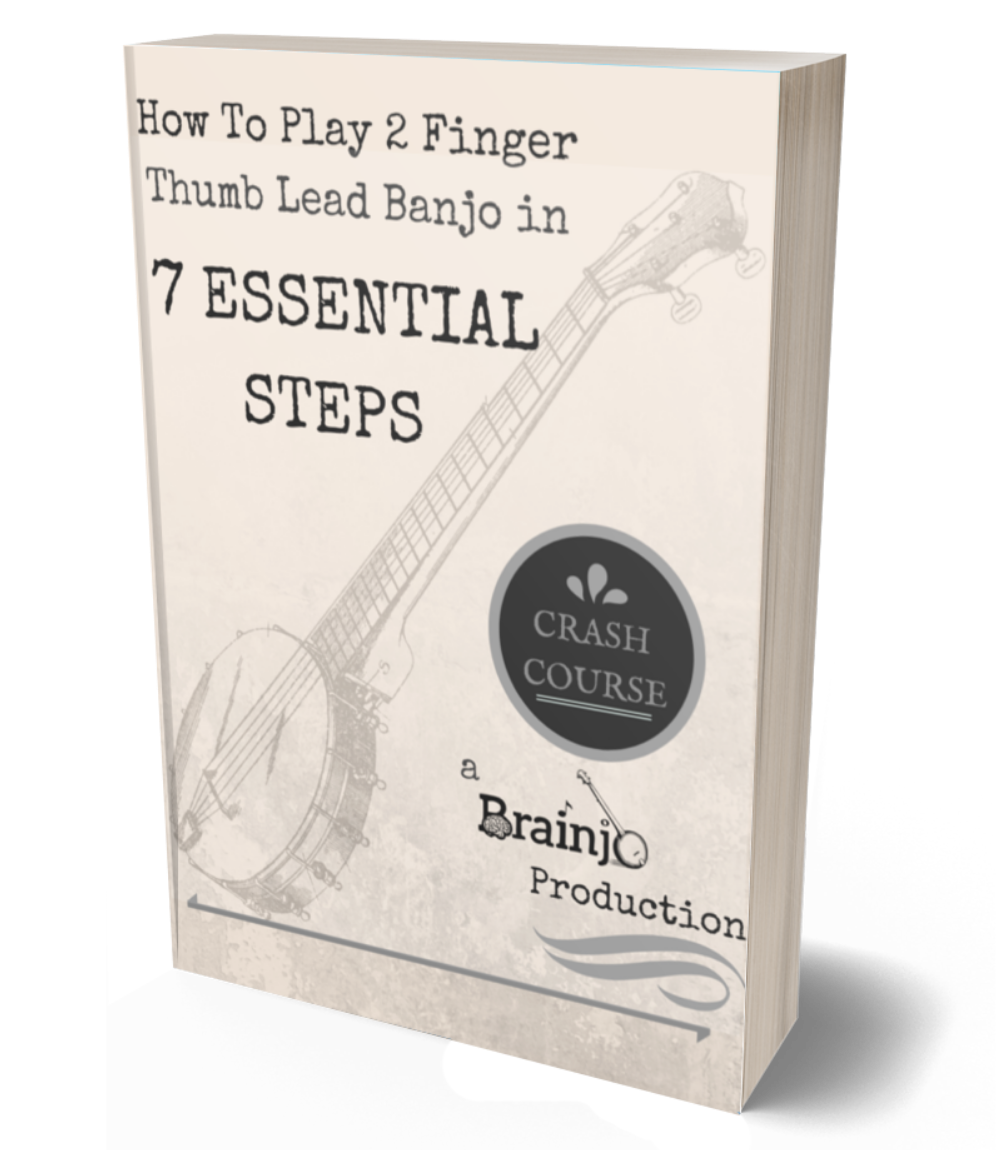The Ultimate Guide To Banjo Styles (Banjo Essential Knowledge Series)
DOWNLOAD THE GUIDE
If you’d like to download the following guide to banjo styles for offline viewing or printing, click the button below.
LEARN TO PLAY THE BANJO THE BRAINJO WAY!
The Breakthrough Banjo Courses for FINGERSTYLE and CLAWHAMMER Banjo are currently FREE for 30 Days. To get started, choose the course you’re interested in below:
The Ultimate Guide To Banjo Styles
Are you new to the banjo and wondering about the differences between all many ways of picking the banjo? Or perhaps you’ve been around the banjo world a bit, but find yourself utterly confused by all the terminology – “Scruggs,” “Melodic,” “Bluegrass,” “Clawhammer,” “Single String,” “Round Peak,” “Frailing,” and so on.
If so, you’re not alone.
One of the reasons things are so confusing here is that people oftentimes use different words to refer to the same thing, or the same word to refer to different things.
In this guide, we’ll break it all down and put an end to the confusion, once and for all!
Play the video below to get the explanation in video form, or keep reading if you prefer. T
Technique vs. Styles
First things first. Part of the confusion in terminology comes from confusing names for different techniques with names for different styles.
A technique of banjo playing refers to the specific technical aspects of playing, or the ways in which you move your arms and fingers to make music.
A style of banjo playing, on the other hand, refers to the consistent use of certain techniques in order to achieve a particular sound.
Understanding this distinction early in your learning journey is critically important. This is because when first learning to play the banjo your focus should be on learning the fundamental techniques – your style will ultimately develop as you grow as a player, but doesn’t really begin until you’ve mastered the technical fundamentals.
What commonly happens instead is that a player is taught a technique AND a style all at once (for example, rather than learning the technical foundation of up-picking, he or she learns Scruggs-style banjo). Conflating style and technique at the start ends up making it harder for you to ever play in any other style than the one you initially learn.
So, in this breakdown, we’ll be clear about which terms refer to differences in technique, and which ones refer to differences in style.
First below is a flow chart that distinguishes between the major technical and stylistic divisions of 5-string banjo playing (read on, or watch the video above, for the full explanation).
5-String Banjo Styles In One Handy Dandy Flow Chart
Up-Picking or Down-Picking?
The biggest distinction of all, and the only decision that should ever really matter when you’re first learning the banjo, is what direction are you picking the strings?
There are really just two ways banjo players pluck the strings of the banjo.
Way #1: Up towards the sky. This is known as “up-picking,” or “fingerstyle,” or “fingerpicking.”
Way #2: Down towards the floor with the back of the nail (using either the index or middle finger). This is known as “down-picking,” or “clawhammer,” or “frailing.”
“Up-picking” and “Down-picking” are technical distinctions.
Up-Picking Techniques
Next, let’s look at the terms to describe the world of up-picking.
Two Fingers or Three?
The next and final technical distinction for up-picking banjo is whether or not you will be picking the strings with two fingers (typically thumb and index) or three fingers (thumb, index, and middle).
If you are playing with two fingers, then naturally playing “2 finger banjo.” If you’re playing with three fingers, then you’re playing “3 finger banjo.”
And that’s it when it comes to the technical divisions of banjo playing. The rest of the terms refer to different styles, or sounds people like to make on the banjo using these techniques.
Up-Picking Styles
Old-Time Music?
The first stylistic question for categorizing the world of 3 finger banjo is “are you playing old-time music on the banjo?”
If the answer is yes, then you’re playing “Old-Time 3 Finger style.”
Below is a video demonstrating Old-Time 3 Finger style:
Emulating Earl Scruggs?
If the answer is no, then the next question is “are you trying to emulate the playing of Earl Scruggs?”
If the answer is yes, then you’re playing “Scruggs style banjo.” You also may be said to be playing “bluegrass banjo,” as Earl Scruggs’s style is considered by many to be the defining sound of bluegrass banjo.
Below is a playlist of 3 Finger Scruggs style banjo:
Playing Melody Notes on Different Strings?
If you’re not trying to emulate the sound of Earl, then our next question is “do you always try to play consecutive melody notes on different strings, or are you okay with playing them on the same string ?”
If the answer is yes, then you’re playing “Melodic,” or “Keith” style banjo. The melodic style is most appropriately used in the context of fiddle tunes, which tend to have a lot of notes per measure. In this style, the banjo player always tries to get consecutive melody notes on different strings, in an effort to preserve the “rolling” sound of the banjo.
Below is a playlist of songs in the 3 Finger Melodic style:
If instead you are perfectly content with playing consecutive melody notes on the same string wherever possible, as is the convention on the guitar, then you are playing “Single String,” or “Reno” style. Naturally, this style of playing is evocative of guitar playing.
And with that we’ve taken care of the major stylistic divisions within 3 finger banjo.
2 Finger Banjo – Who’s Playing Melody?
One simple question will determine the major stylistic divisions in 2 finger banjo. And that question is – “what finger is playing the melody?”
In 2-finger thumb lead banjo, the thumb is primarily responsible for playing the melody notes.
Below is a playlist of 2 Finger Thumb Lead songs:
In 2-finger index lead banjo, the index finger is primarily responsible for playing the melody notes.
Here is an example of 2 finger index lead by the great Will Keys:
But, just as a reminder, these 2 finger styles are not differences in technique, as both involve the same exact movements of the hands.
LEARN THE FOUNDATIONS OF UP-PICKING
For the free Brainjo Method course for learning up-picking technique, click here.
Down-Picking Styles
Now let’s dive into the primary stylistic divisions in the world of down-picking, or clawhammer, banjo. Remember, all of these styles deploy the same fundamental techniques.
Playing Minstrel Songs?
Our first question here is “are you playing songs written for minstrel banjo players?”
If so, then you are playing “Minstrel” banjo (sometimes also referred to as “Stroke Style”). Here we’re referring to the repertoire of songs played by banjo players who played in the era of minstrel shows from the early 19th to early 20th century.
Below is an example of Minstrel banjo:
Round Peak?
If you aren’t playing minstrel-era songs on your banjo, then our next question is “are you trying to emulate the playing of Round Peak banjoists?”
If your answer is yes, then you’re playing “Round Peak Style” banjo.
Round Peak refers to a small region in North Carolina that was home to several iconic fiddle and banjo players who all developed and shared a similar aesthetic. On the banjo, this was characterized by a sparse use of brush strokes (or strums), liberal use of drop thumbing, and a driving “bump-a-ditty” rhythm.
Below is an example of Round Peak banjo played by the great Tommy Jarrell:
Playing All The Notes?
If you are not trying to emulate the sound of Round Peak banjoists, then our next question is “are you trying to play all the notes of the fiddle tunes?”
We’ve already discussed the “melodic” style as it applies to 3-finger technique. Here, we have the analogous term applied to clawhammer.
Fiddle tunes represent a substantial part of the traditional clawhammer banjo repertoire. In “Melodic Clawhammer,” the banjo player aims to play as many of the notes of the fiddle tune as possible.
Below is an example of clawhammer banjo in the Melodic style:
If your answer is no, then you may simply refer to your style as “clawhammer banjo.”
Below is a playlist of the Clawhammer Banjo Channel’s “Top 10”:
And there you have it!
We’ve now successfully broken down the wonderful and strange world of banjo styles. You are now fully equipped to go forth and use these terms with abandon.
Final Thoughts
Again, these are major divisions, and the ones you’re most likely to hear used. More importantly, the ones you’re most likely to be confused by.
In truth, every single banjo player has his or her own style. And, if we wanted to, we could dig into the specifics of its signature elements.
Doing that sort of thing can be useful if you’re trying to better understand how a particular player achieves his or her own signature sound.
LEARN THE FOUNDATIONS OF DOWN-PICKING
For the free Brainjo Method course for learning up-picking technique, click here.


